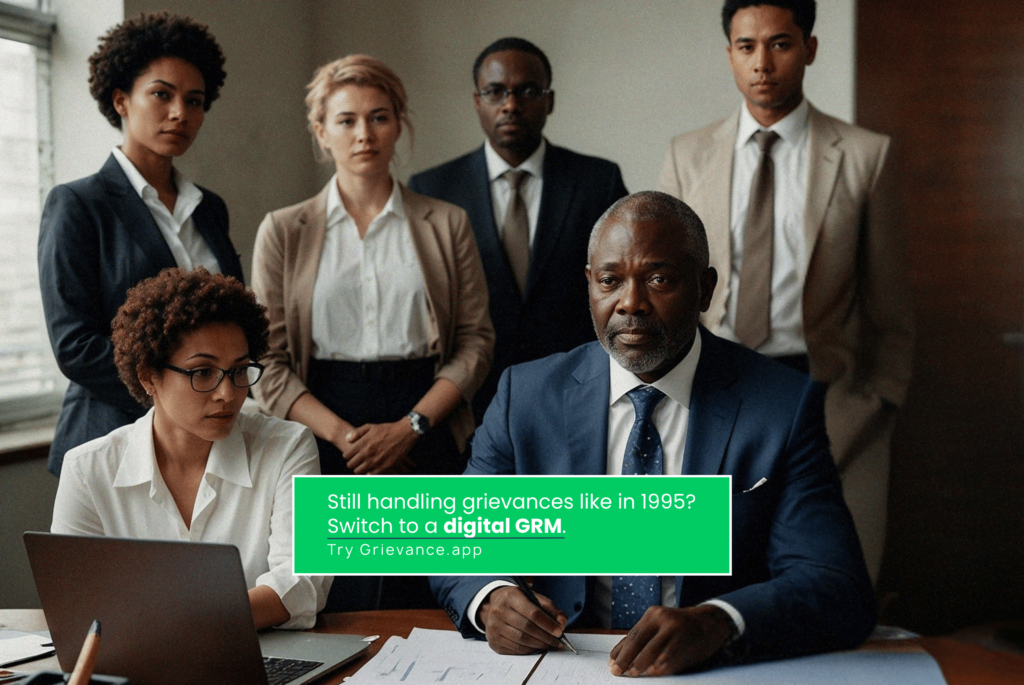Why Every Organization Needs a Digital Grievance Redress Mechanism (GRM) in 2025

The digital grievance redress mechanism (GRM) has become an essential tool. In 2025, transparency, accountability, and trust will no longer be mere perks for organizations; they will become essential strategic pillars. Whether for businesses, NGOs, or public institutions, grievance management plays a crucial role in their reputation, compliance, and overall performance.
In this context, the digital Grievance Redress Mechanism (GRM) appears to be an essential solution, meeting the growing demands for efficiency and modernity.
Stakeholder grievances can be efficiently collected, processed, and tracked using a digital GRM, which is a structured platform. It is more than just a feedback channel; it embodies responsible governance, proactive risk management, and a commitment to sustainable development. Learn why every organization must adopt a digital GRM in 2025 to remain competitive, compliant, and trustworthy.
What Is a Digital Grievance Redress Mechanism (GRM)?
A digital GRM is a technological solution that allows organizations to:
- Receive complaints in real-time through multiple channels (web, mobile, SMS).
- Automatically classify reports by urgency or theme.
- Assign cases to the relevant teams with controlled deadlines.
- Document every step of the process for full traceability.
- Provide transparent responses to complainants.
Unlike manual systems (suggestion boxes, paper forms), a digital GRM is interactive, secure, and tailored to the expectations of the digital age.
5 Key Benefits of Digital GRM for Organizations
- Enhanced Transparency and Accountability: Every grievance is timestamped, tracked, and stored, reducing the risks of corruption or unfair treatment. Stakeholders can monitor the progress of their case in real-time.
- Simplified regulatory compliance: ESG (Environmental, Social, and Governance) standards and the requirements of international donors make digital GRMs mandatory for many sectors. It also facilitates audited reporting.
- Proactive risk management: The GRM acts as an early warning system, identifying potential conflicts or malfunctions before they escalate.
- Continuous Service Improvement: Analyzed feedback helps correct errors, adapt policies, and train teams.
- Strengthened Stakeholder Trust: An accessible (and anonymous, if needed) and responsive channel demonstrates that the organization listens and acts, enhancing its image and legitimacy.
Why Is 2025 a Turning Point for Digital GRMs?
- High user expectations: Citizens, customers, or beneficiaries demand quick and accessible responses from their smartphones.
- AI and automation: Semantic sorting, chatbots, and automated reports enable the handling of large volumes without administrative overload.
- Donor requirements: Funded projects (energy, infrastructure, health) often require digital GRM to comply with international standards ( World Bank, UN).
How to Implement an Effective Digital Grievance Redress Mechanism (GRM)?
- Audit the specific needs of your organization and your stakeholders.
- Choose a specialized platform like Grievance.app, designed for compliant and intuitive complaint management.
- Train teams on using the system and response protocols.
- Promote the GRM through internal and external campaigns to maximize adoption.
- Analyze data to continuously improve processes and prevent recurrences.
Conclusion: The Digital GRM, a Pillar of Governance in 2025
In 2025, lacking a digital Grievance Redress Mechanism (GRM) means risking a reputational crisis, regulatory penalties, or a loss of trust. For any organization aiming for operational excellence and positive impact, it is a strategic investment.
➤ Try Grievance.app for free and turn your grievances into performance drivers.
FAQ – Digital GRM
Q: What is a Grievance Redress Mechanism (GRM)?
A: A Grievance Redress Mechanism (GRM) is a structured process for collecting, reviewing, and resolving complaints from stakeholders in a timely and effective way, especially within projects or public services.
Q: Why use a digital GRM instead of a manual system?
A: Digital GRMs simplify grievance handling by offering real-time tracking, automated notifications, and data analytics—features that are impossible to implement with manual paper-based systems.
Q: How does a digital GRM work in practice?
A: In practice, a digital GRM allows users to submit complaints online, which are then logged, categorized, and assigned to responsible staff for resolution. The system tracks progress and notifies users of updates.
Q: Is a digital GRM required for donor-funded projects?
A: International donors such as the World Bank, the UN, and the EU often mandate the use of a digital GRM to ensure that complaints are documented, tracked, and resolved transparently, especially in sectors with social or environmental risks.
